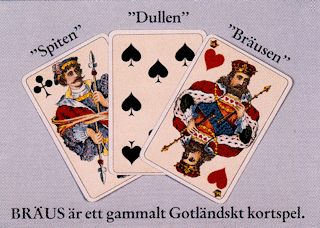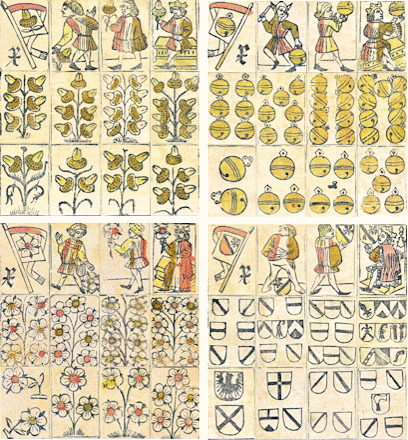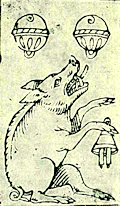The oldest
.gif)
Court cards from 15th century Swiss pack.
Karnöffel is the Under of trumps
identifiable European card game is first attested in 1426 in a town ordinance of Nördlingen,
Bavaria, that permits councillors to play it at the annual festival. Many 15th-century references
thereafter chart the game's increasing popularity in southern Germany and provide useful descriptive
details. That game was Karnöffel (rhymes approximately with kerfuffle, with N replacing the first F),
also known as Kaiserpiel or Ludus Imperatoris, the Kaiser or Emperor's game.
Some details of its nature and specific features appear in two important texts give. One, a substantial poem by Meissner from around 1450, celebrates the game as being popular with both sexes; the other, a sermon of 1496 delivered by Bishop Geiler in Kaiserberg, attacks it for its brazen promotion of a revolutionary social order. From these we learn that it was played with German-suited cards of acorns, leaves, hearts and bells (hawk-bells), and court cards depicting King, Ober and Unter, the last two equivalent to our Queen and Jack, but both male. There is a trump suit, of sorts - actually called "the elected suit" (gewählte Farbe) - of which the highest is the Unter, itself the eponymous Karnöffel. Next highest is the Six, called "the Pope", followed by the Daus or Deuce, the alternatively eponymous "Kaiser". Also significant is the trump Seven, known as "the Devil", which when led can be beaten only by Karnöffel, but otherwise loses, having no power even as a trump.
So what exactly
.gif)
Jörg Ratgeb: detail from the wing of the Herrenberg Altar depicting the
resurrection, 1517-19 (Staatsgalerie, Stuttgart). One of the Landsknechte
appears
to have a hernia; the cards (enlarged in detail) imply Karnöffel.
does Karnöffel mean? Some have sought, not very convincingly I think, to
derive it from the Persian Kanjifeh (cf modern Indian Ganjifa), a card game possibly played with the
original Mamluk pack from which European cards were copied; others from the French cornifle,
the horned pondweed (what's that go to do with it?); yet others connect it with the word carnival. In
fact its primary meaning is a scrotal hernia and, by extension in some contexts, the testicles. By
further extension it also came to mean a rough, uncouth and violent rogue, thence a Landsknecht or
lansquenet, and, later still, satirically, a cardinal of the church. Hardly surprising, then, that
bishop Geiler says he would gladly have the whole lot thrown into the bonfire.
Forms of Karnöffel
were being played in Switzerland by the first
decade of the 16th century, in Berlin and Lübeck soon after, Thuringia in the 18th century,
Westphalia in the 19th, and Friesland perhaps beyond the 1920s. Since card-game books did not appear
before about 1650 the rules of
Karnöffel were long considered irrecoverable.

Karnöffel's descendant Bräus is still played in Gotland
In the 1970s, however, Dr Rudolf van Leyden
(1908-83), a former president of the
International Playing Card Society discovered a
game that almost exactly fitted its description being played in a few remote valleys of Switzerland
under its alternative name Kaiserspiel, or Kaiserjass. Since then, further exploration has opened
up a whole family of related games still played throughout northern Europe. They include, besides
Kaiserspiel itself:
Alkort
and its three-player variant
Treikort (Iceland),
Bräus (Gotland),
Stýrivolt (Faroes),
Watten (Bavaria), and
Vorms (Greenland).
Rules for all these games, mostly based on research by Dr Anthony Smith, appear on the
Pagat website, and all except Treikort in part 12
of my Penguin Book of Card Games, which is also available as an e-book on Kindle.
Also worth mentioning is Karnüfflen, played in North Friesland (the north-western district of
Schleswig-Holstein) until the early 20th century.
Karnöffel is as much a game

48-card Swiss's-suited Karnöffel pack, c 1530
of technical as of social significance
in that itself and its modern descendants display several distinctive habits. One is that you don't
have to follow suit but can always play any card you like. Another is that instead of a trump suit in
the usual sense of the word, certain individual cards have special names and act as quasi-trumps, or
enjoy particular powers of their own. An amusing feature (though not unique to this family) is
the practice, in partnership varieties, of signalling the holding of certain high cards to one's
partner by means of codified nods, winks and grimaces, ideally made when the other side is not
looking. This does not constitute "organised cheating", as some call it, but is merely a system
of conventions, like opening Two Clubs at Bridge to denote a strong hand. Because Karnöffel
itself is first mentioned at about the same time as the invention of real trumps, in Tarot games,
it may be that some of these features go right back to games played when cards first reached Europe
around 1360, and that the invention of trumps may have been inspired by the concept of individual
cards with special powers. Which of Tarot and Karnöffel influenced the other, or whether both
perpetuated an existing practice, remains at present indeterminable.
As to its social significance,

The Daus (Deuce),
aka die Sau (the
Sow), on a card of
1593
it was so clearly an anarchic game that civic and ecclesiastical authorities often objected to it.
Bishop Geiler, as we have seen, saw Karnöffel as the
embodiment of that medieval nightmare "the world turned upside down". Ordinary card games, whatever
their demerits, at least reflect a sensible social order, with the King superior
to the Ober, the Ober to the Unter, and so on. "But now", he complains, "we have a
game called Karniffelspiel in which everything is turned upside down: the 3s beat an Ober, the 4 beats
the Unter, the 2 and the 6 beat a King; and a card is turned over, so that now one is Kaiser, now
another becomes Kaiser, as luck will have it." He would like to burn them all, including "the King,
the Kaiser, the Ober, the Banner and the Devil". (The Banner, in Swiss cards, is equivalent to our
Ten, though its suit symbol is displayed only once.)
Other references to named cards and disturbed ranking include a satirical work of 1546 in the form of a dialogue between the Pope and the Devil, from which, as Dummett puts it (in The Game of Tarot), "We learn that neither of the Devil and the Pope beats the other; that the Pope beats all the cards, including the Kaiser and the Kings, with the exception of the Karnöffel; that the Karnöffel beats the Pope, the Devil and all other cards; that the Karnöffel is an Unter [that is, the highest card is a Jack]... the 2 beats the King, the Obers and the other Kaisers; and that the 5 is beaten by all other Kaisers, and by the King, Ober, Pope and Karnöffel, but beats only the 10, 9, 8, etc." Karnöffel was evidently enjoyed as a substitute for anarchy, and whether it was forbidden or permitted in various fifteenth-century ordinances obviously hinged more on political perceptions than on the ethics of gambling.
Other variations occur in descriptions of the game from various parts of northern Europe, but its peculiar essence has remained unchanged and undoubtedly dates back to its earliest report. Karnöffel is remarkable for its early display of features common to many later games of different types. The superiority of the Jack of trumps appears in later games like All Fours and Loo, while the aim of winning at least three tricks out of five underlies the whole family of five-card games represented by (for example) Triomphe, Ecarté and Twenty-Five. And, of course, the very fact that the lowest card (2) beats the highest is perpetuated to this day in the superiority of the Ace over the King in nearly all European card games.
The following reconstruction is redacted from the rules of early Karnöffel presented by Michael Dummett in van Leyden's study of the game. I have, however, converted the original suits and courts from early Swiss cards to those of the modern French-suited pack. If you prefer to play with more authentic cards then you should try the current Swiss form of the game, Kaiserspiel, as described on the Pagat website.
- Cards and players
- 2, 4, 6 or 8 play with a 48-card pack lacking Aces. Four or more players form two partnerships of two each and each player sits with an opponent on either side. The deal and play pass always to the left.
- Draw for partners
- Draw cards to establish partners and first dealer. With more than two players, those drawing the lowest cards become partners, as do those drawing the highest. Whoever draws lowest deals first. For this purpose cards rank downwards KQJ1098765432 and, as between cards of equal rank, suits rank downwards spades, clubs, hearts, diamonds. Return the drawn cards to the pack prior to shuffling and dealing.
- Target score
- Next, decide on a target score. This should be one more than a multiple of 10, typically 101. The basic value of a round is 4 points, but, during the deal, each player has three opportunities to propose an increase of 3 points. If a proposal is refused, the side refusing it loses the existing value and there is a new deal by the next dealer. During the deal, a trump suit is determined, and the ranking of trumps differs from that of the plain suits, as explained later.
- Object
- In each round, to win three of the five tricks played.
- Deal
- Start by dealing each player one card face up. The suit of the lowest-ranking of these, or the
first dealt of equally lowest, becomes trump. Unless two play, the dealer next gives a card face up to
Forehand (dealer's left-hand neighbour) and another to the second player, then waits. Forehand may
propose an increase in the value of the round by 3 points, bringing it to 7 points, and may discuss
with their partner(s) whether or not to do so. If Forehand proposes, the second player may (also with
discussion if desired): -
1. Accept the increase, fixing the value at 7 points; or
2. Surrender, in which case the proposer's side scores 4 and the proposer deals to the next round; or
3. Propose a further increase of 3 points, bringing the value 10. In this case, Forehand may refuse, in which case the proposer's side wins a round worth 7 and the next round is dealt, or accept, in which case the value is fixed at 10. If Forehand does not propose, the second player may then do so. In the second and third rounds of the deal each player receives two cards face down. After each pair of cards dealt to each of two players there is another pause, in which each of those two in turn, having looked at their cards, may propose an increase of 3 points and either accept such a proposal from the other or surrender the round. When four play, any two partners may privately show their cards to each other and discuss whether or not to propose or surrender. With six or more, each side appoints one of their number as director. Then anyone who has just been dealt cards may pass them to their director to look at, and receive advice on whether to propose, accept or refuse an increase. If, during the deal, the value of the round reaches a level sufficient for one side to win, given its present score, some member of that side should announce the fact, and no one may then propose any further increase. (Exception: If at the start of a deal one side is within 4 points of winning and the other side notices this, they are not obliged to draw attention to it but may keep proposing increases till their opponents become aware of the situation and announce it to prohibit further increases.) In the two-player game, each of course may propose and either accept or refuse on their own behalf. - Play
- Forehand leads to the first trick (any card except trump 7) and the winner of each trick leads to
the next. Play stops as soon as one side has won three tricks, thereby scoring the value of the round
as determined during the deal. There is no need to follow suit (ever), and the trick is taken by the
highest card of the suit led or by the highest trump or special card if any are played. The ranking
order of cards in plain suits is the same as in the draw (KQJ1098765432).
Of the so-called trump suit (actually it is merely called the "elected" suit), only three are real
trumps (J, 6, 2) and three are only partial trumps (3, 4, 5). The others have no trumping power at all
so might as well be regarded as constituting a fourth plain suit of
their own. As between themselves, trumps rank from highest to lowest: -
Trump 7, the Devil, has a special role. If led to a trick it beats everything except Karnöffel, but if played from any other position it always loses. Note: It may not be led as the first card to the first trick. To illustrate the powers listed above, suppose that, in an eight-handed game, spades are trumps, and the lead of (say)trump : properties Karnöffel = J : beats everything Pope = 6 : trumps plain suits Kaiser = 2 : trumps plain suits 3 : trumps plain suits but not Kings 4 : trumps plain suits but not K, Q 5 : trumps plain suits but not K, Q, J K : no trumping power Q : no trumping power 10 : no trumping power 9 : no trumping power 8 : no trumping power The Devil = 7 : if led beaten only by Karnöffel, otherwise loses  9 is followed, in succession, by
9 is followed, in succession, by
 5,
5,
 J,
J,
 4,
4,
 Q,
Q,
 3,
3,
 K, and the Pope
(
K, and the Pope
( 6): then each card in turn beats
the preceding one.
During play no one may look at anyone else's cards. However, in the four-handed game, each player
will already have seen their partner's cards, and, in the six-handed and eight-handed games, the
director of each side will have seen their partners' cards. In the four-handed game, any player
may advise their partner, or seek their partner's advice, on which card to play; and any such
advice must be given aloud for the opponents to hear. In the six-handed and eight-handed games,
the director may similarly advise partners what to play.
6): then each card in turn beats
the preceding one.
During play no one may look at anyone else's cards. However, in the four-handed game, each player
will already have seen their partner's cards, and, in the six-handed and eight-handed games, the
director of each side will have seen their partners' cards. In the four-handed game, any player
may advise their partner, or seek their partner's advice, on which card to play; and any such
advice must be given aloud for the opponents to hear. In the six-handed and eight-handed games,
the director may similarly advise partners what to play. - Game
- At the end of a game the losers pay the winners an agreed stake - doubled if they score less than half the target score, and trebled if they finished with a score of zero.




